Nuclear Rules and Regulations Course Homework Solution
VerifiedAdded on 2021/04/21
|10
|2259
|68
Homework Assignment
AI Summary
This homework assignment delves into the intricacies of nuclear rules and regulations, addressing key aspects such as environmental reporting requirements under 10 CFR 50, the role and function of the Defense Nuclear Facilities Safety Board (DNFSB), and the responsibilities of the Nuclear Waste Technical Review Board (NWTRB). The assignment explores accident analysis techniques referenced in NUREG-1513 and compares consequence threshold limits between DOE and NRC guidelines. It also outlines the required steps for performing an Integrated Safety Analysis. The student utilizes the NRC website, DNFSB reports, and NWTRB information to answer questions regarding nuclear facility safety, waste management, and environmental impact assessment. The analysis covers topics including environmental reports, DNFSB's role, NWTRB's functions, accident analysis methods, and safety analysis comparisons, providing a comprehensive overview of nuclear regulatory frameworks and safety protocols.
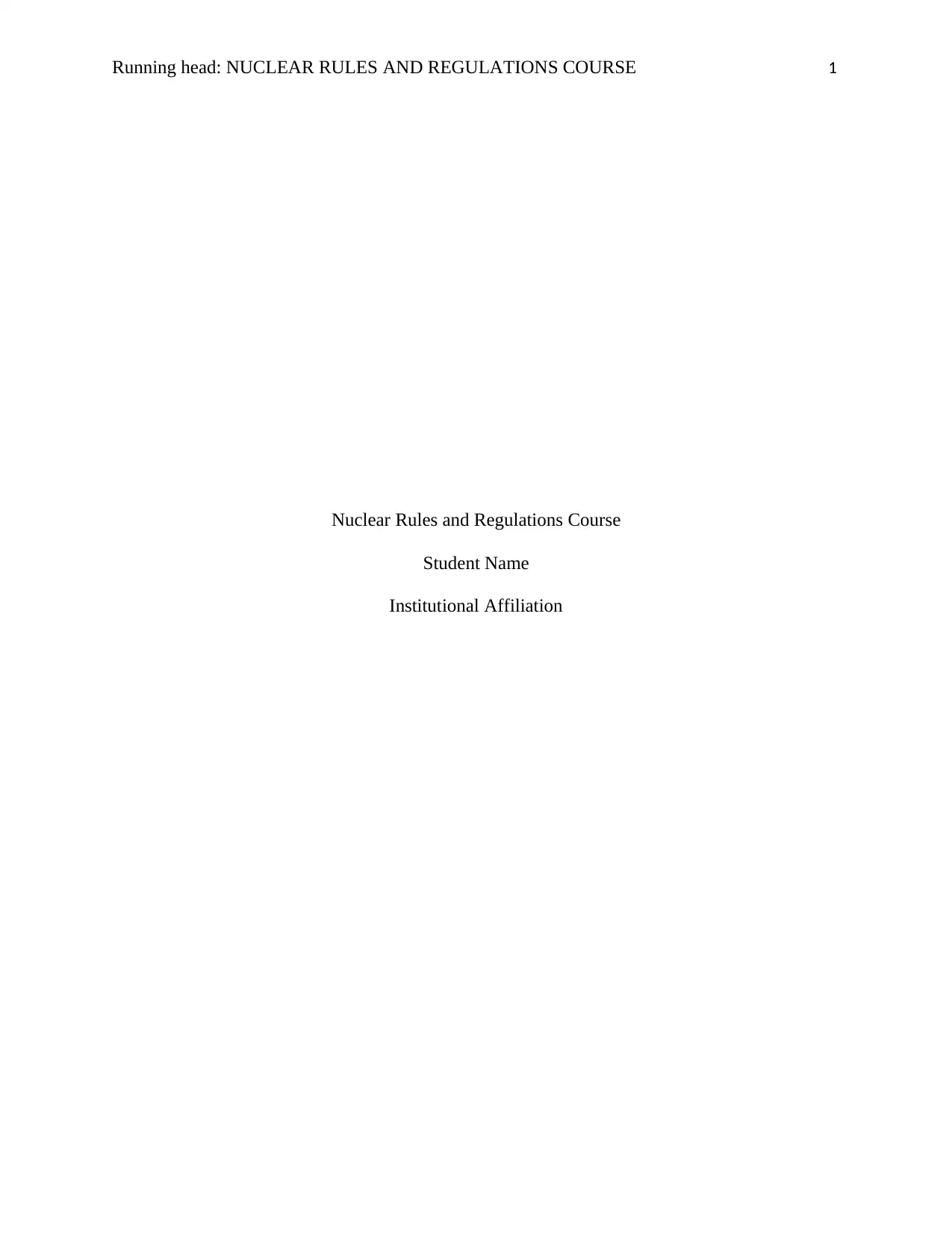
Running head: NUCLEAR RULES AND REGULATIONS COURSE 1
Nuclear Rules and Regulations Course
Student Name
Institutional Affiliation
Nuclear Rules and Regulations Course
Student Name
Institutional Affiliation
Paraphrase This Document
Need a fresh take? Get an instant paraphrase of this document with our AI Paraphraser
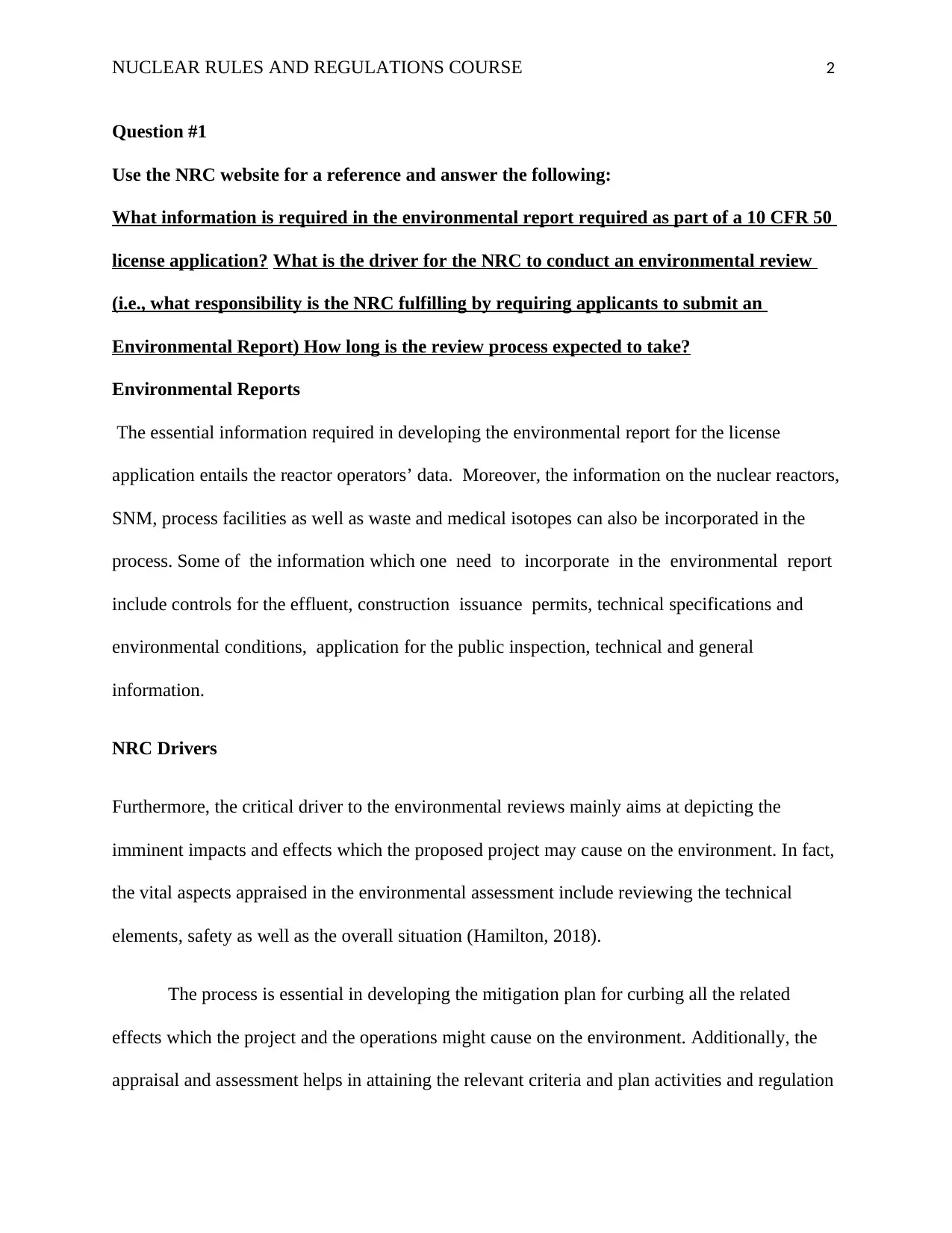
NUCLEAR RULES AND REGULATIONS COURSE 2
Question #1
Use the NRC website for a reference and answer the following:
What information is required in the environmental report required as part of a 10 CFR 50
license application? What is the driver for the NRC to conduct an environmental review
(i.e., what responsibility is the NRC fulfilling by requiring applicants to submit an
Environmental Report) How long is the review process expected to take?
Environmental Reports
The essential information required in developing the environmental report for the license
application entails the reactor operators’ data. Moreover, the information on the nuclear reactors,
SNM, process facilities as well as waste and medical isotopes can also be incorporated in the
process. Some of the information which one need to incorporate in the environmental report
include controls for the effluent, construction issuance permits, technical specifications and
environmental conditions, application for the public inspection, technical and general
information.
NRC Drivers
Furthermore, the critical driver to the environmental reviews mainly aims at depicting the
imminent impacts and effects which the proposed project may cause on the environment. In fact,
the vital aspects appraised in the environmental assessment include reviewing the technical
elements, safety as well as the overall situation (Hamilton, 2018).
The process is essential in developing the mitigation plan for curbing all the related
effects which the project and the operations might cause on the environment. Additionally, the
appraisal and assessment helps in attaining the relevant criteria and plan activities and regulation
Question #1
Use the NRC website for a reference and answer the following:
What information is required in the environmental report required as part of a 10 CFR 50
license application? What is the driver for the NRC to conduct an environmental review
(i.e., what responsibility is the NRC fulfilling by requiring applicants to submit an
Environmental Report) How long is the review process expected to take?
Environmental Reports
The essential information required in developing the environmental report for the license
application entails the reactor operators’ data. Moreover, the information on the nuclear reactors,
SNM, process facilities as well as waste and medical isotopes can also be incorporated in the
process. Some of the information which one need to incorporate in the environmental report
include controls for the effluent, construction issuance permits, technical specifications and
environmental conditions, application for the public inspection, technical and general
information.
NRC Drivers
Furthermore, the critical driver to the environmental reviews mainly aims at depicting the
imminent impacts and effects which the proposed project may cause on the environment. In fact,
the vital aspects appraised in the environmental assessment include reviewing the technical
elements, safety as well as the overall situation (Hamilton, 2018).
The process is essential in developing the mitigation plan for curbing all the related
effects which the project and the operations might cause on the environment. Additionally, the
appraisal and assessment helps in attaining the relevant criteria and plan activities and regulation
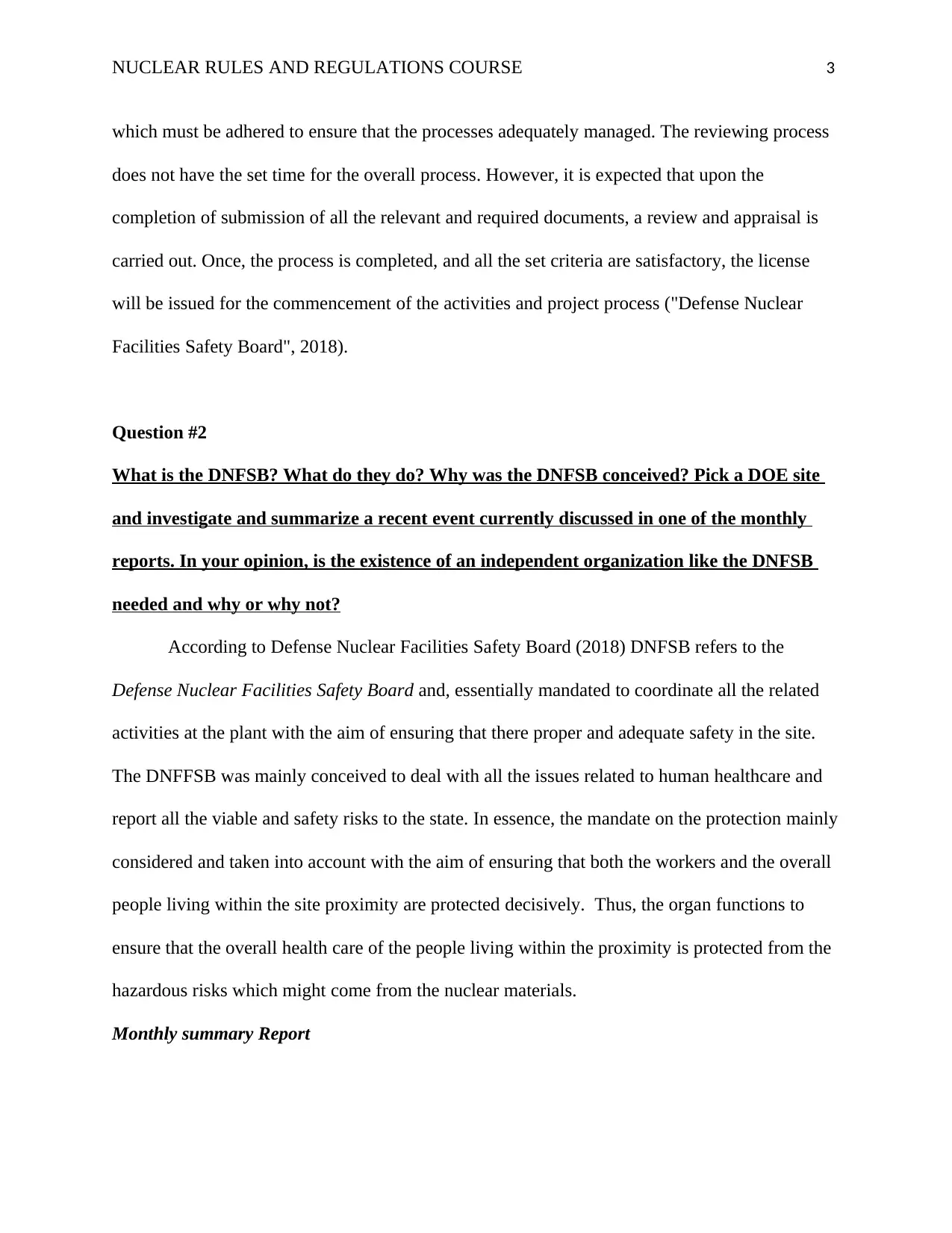
NUCLEAR RULES AND REGULATIONS COURSE 3
which must be adhered to ensure that the processes adequately managed. The reviewing process
does not have the set time for the overall process. However, it is expected that upon the
completion of submission of all the relevant and required documents, a review and appraisal is
carried out. Once, the process is completed, and all the set criteria are satisfactory, the license
will be issued for the commencement of the activities and project process ("Defense Nuclear
Facilities Safety Board", 2018).
Question #2
What is the DNFSB? What do they do? Why was the DNFSB conceived? Pick a DOE site
and investigate and summarize a recent event currently discussed in one of the monthly
reports. In your opinion, is the existence of an independent organization like the DNFSB
needed and why or why not?
According to Defense Nuclear Facilities Safety Board (2018) DNFSB refers to the
Defense Nuclear Facilities Safety Board and, essentially mandated to coordinate all the related
activities at the plant with the aim of ensuring that there proper and adequate safety in the site.
The DNFFSB was mainly conceived to deal with all the issues related to human healthcare and
report all the viable and safety risks to the state. In essence, the mandate on the protection mainly
considered and taken into account with the aim of ensuring that both the workers and the overall
people living within the site proximity are protected decisively. Thus, the organ functions to
ensure that the overall health care of the people living within the proximity is protected from the
hazardous risks which might come from the nuclear materials.
Monthly summary Report
which must be adhered to ensure that the processes adequately managed. The reviewing process
does not have the set time for the overall process. However, it is expected that upon the
completion of submission of all the relevant and required documents, a review and appraisal is
carried out. Once, the process is completed, and all the set criteria are satisfactory, the license
will be issued for the commencement of the activities and project process ("Defense Nuclear
Facilities Safety Board", 2018).
Question #2
What is the DNFSB? What do they do? Why was the DNFSB conceived? Pick a DOE site
and investigate and summarize a recent event currently discussed in one of the monthly
reports. In your opinion, is the existence of an independent organization like the DNFSB
needed and why or why not?
According to Defense Nuclear Facilities Safety Board (2018) DNFSB refers to the
Defense Nuclear Facilities Safety Board and, essentially mandated to coordinate all the related
activities at the plant with the aim of ensuring that there proper and adequate safety in the site.
The DNFFSB was mainly conceived to deal with all the issues related to human healthcare and
report all the viable and safety risks to the state. In essence, the mandate on the protection mainly
considered and taken into account with the aim of ensuring that both the workers and the overall
people living within the site proximity are protected decisively. Thus, the organ functions to
ensure that the overall health care of the people living within the proximity is protected from the
hazardous risks which might come from the nuclear materials.
Monthly summary Report
⊘ This is a preview!⊘
Do you want full access?
Subscribe today to unlock all pages.

Trusted by 1+ million students worldwide
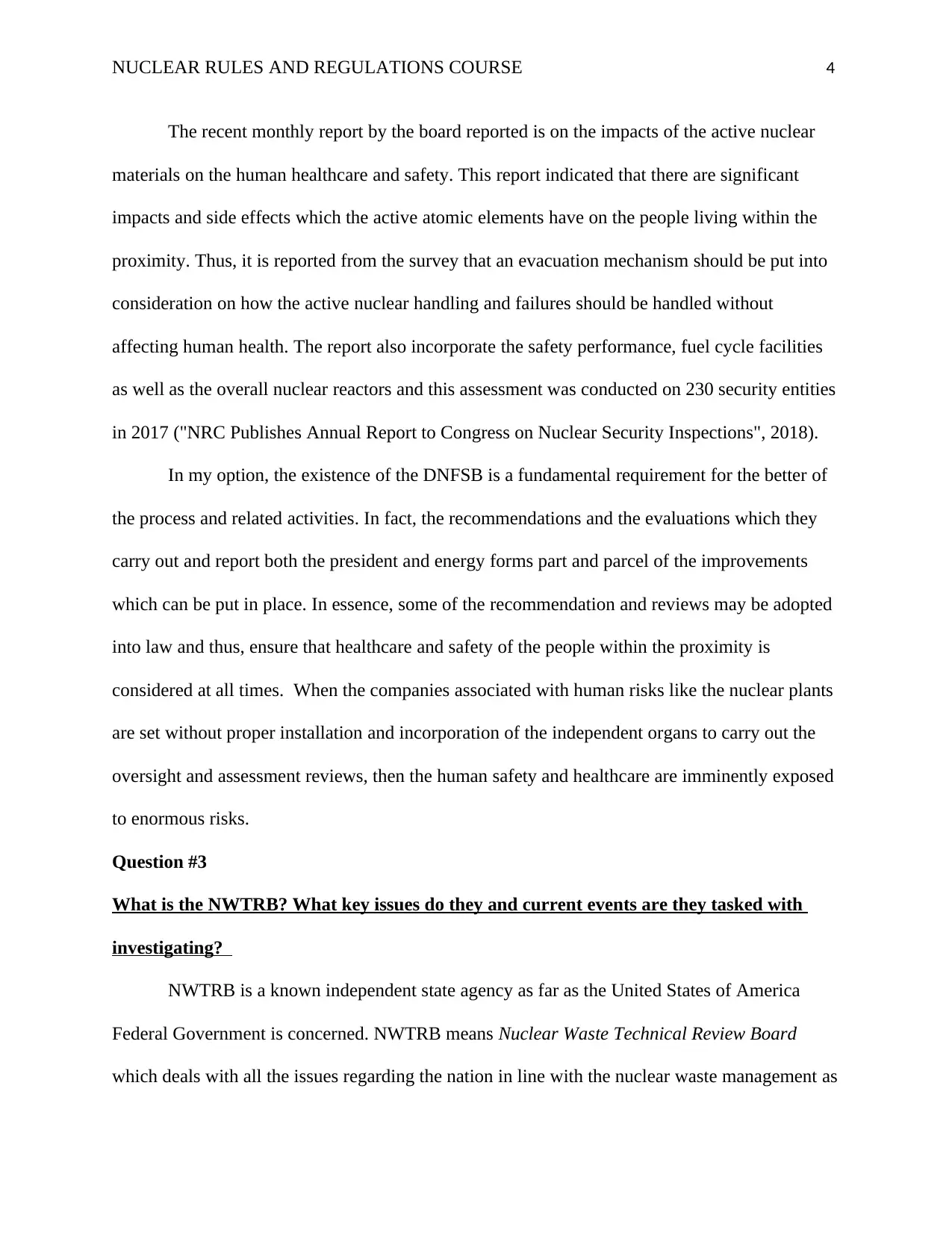
NUCLEAR RULES AND REGULATIONS COURSE 4
The recent monthly report by the board reported is on the impacts of the active nuclear
materials on the human healthcare and safety. This report indicated that there are significant
impacts and side effects which the active atomic elements have on the people living within the
proximity. Thus, it is reported from the survey that an evacuation mechanism should be put into
consideration on how the active nuclear handling and failures should be handled without
affecting human health. The report also incorporate the safety performance, fuel cycle facilities
as well as the overall nuclear reactors and this assessment was conducted on 230 security entities
in 2017 ("NRC Publishes Annual Report to Congress on Nuclear Security Inspections", 2018).
In my option, the existence of the DNFSB is a fundamental requirement for the better of
the process and related activities. In fact, the recommendations and the evaluations which they
carry out and report both the president and energy forms part and parcel of the improvements
which can be put in place. In essence, some of the recommendation and reviews may be adopted
into law and thus, ensure that healthcare and safety of the people within the proximity is
considered at all times. When the companies associated with human risks like the nuclear plants
are set without proper installation and incorporation of the independent organs to carry out the
oversight and assessment reviews, then the human safety and healthcare are imminently exposed
to enormous risks.
Question #3
What is the NWTRB? What key issues do they and current events are they tasked with
investigating?
NWTRB is a known independent state agency as far as the United States of America
Federal Government is concerned. NWTRB means Nuclear Waste Technical Review Board
which deals with all the issues regarding the nation in line with the nuclear waste management as
The recent monthly report by the board reported is on the impacts of the active nuclear
materials on the human healthcare and safety. This report indicated that there are significant
impacts and side effects which the active atomic elements have on the people living within the
proximity. Thus, it is reported from the survey that an evacuation mechanism should be put into
consideration on how the active nuclear handling and failures should be handled without
affecting human health. The report also incorporate the safety performance, fuel cycle facilities
as well as the overall nuclear reactors and this assessment was conducted on 230 security entities
in 2017 ("NRC Publishes Annual Report to Congress on Nuclear Security Inspections", 2018).
In my option, the existence of the DNFSB is a fundamental requirement for the better of
the process and related activities. In fact, the recommendations and the evaluations which they
carry out and report both the president and energy forms part and parcel of the improvements
which can be put in place. In essence, some of the recommendation and reviews may be adopted
into law and thus, ensure that healthcare and safety of the people within the proximity is
considered at all times. When the companies associated with human risks like the nuclear plants
are set without proper installation and incorporation of the independent organs to carry out the
oversight and assessment reviews, then the human safety and healthcare are imminently exposed
to enormous risks.
Question #3
What is the NWTRB? What key issues do they and current events are they tasked with
investigating?
NWTRB is a known independent state agency as far as the United States of America
Federal Government is concerned. NWTRB means Nuclear Waste Technical Review Board
which deals with all the issues regarding the nation in line with the nuclear waste management as
Paraphrase This Document
Need a fresh take? Get an instant paraphrase of this document with our AI Paraphraser
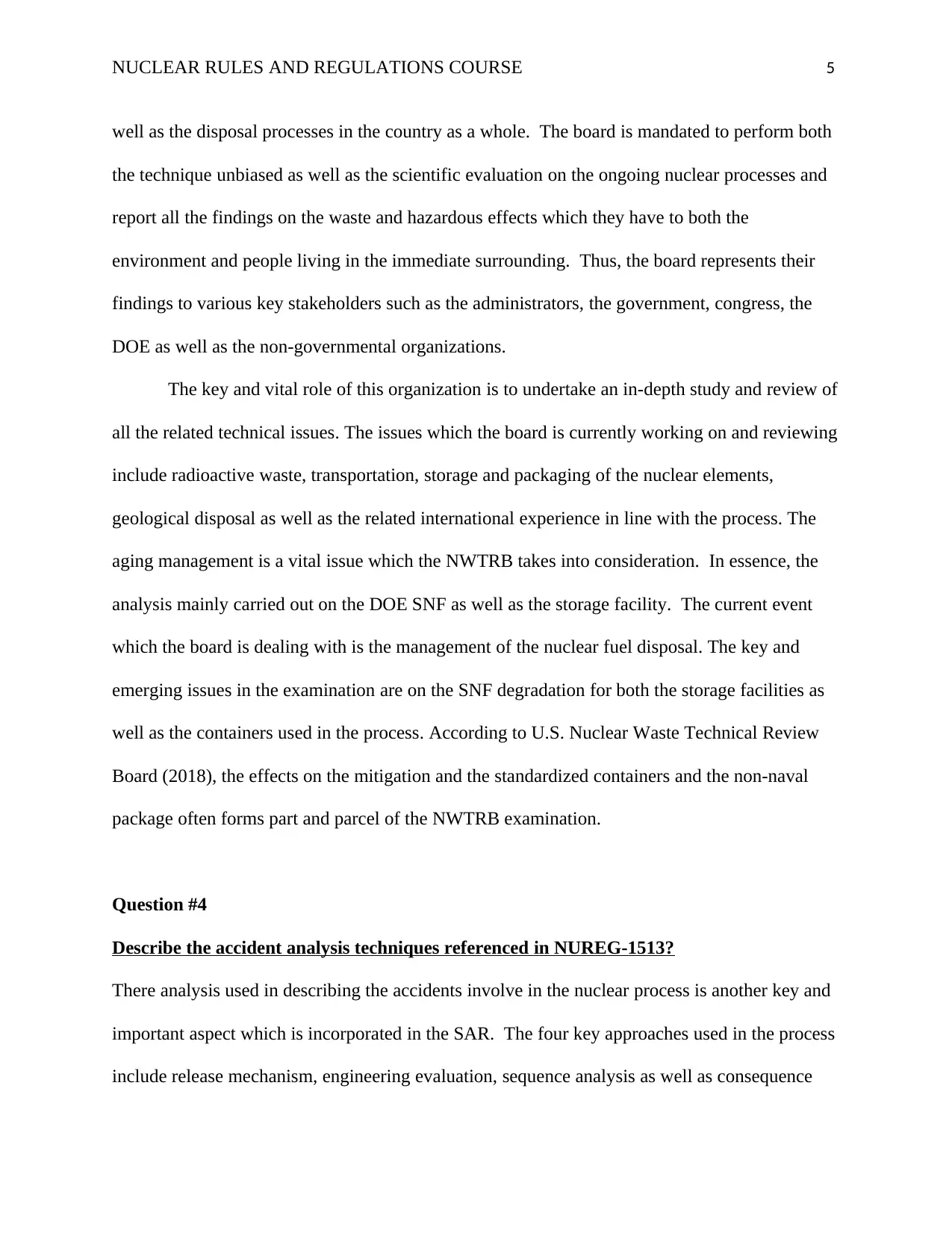
NUCLEAR RULES AND REGULATIONS COURSE 5
well as the disposal processes in the country as a whole. The board is mandated to perform both
the technique unbiased as well as the scientific evaluation on the ongoing nuclear processes and
report all the findings on the waste and hazardous effects which they have to both the
environment and people living in the immediate surrounding. Thus, the board represents their
findings to various key stakeholders such as the administrators, the government, congress, the
DOE as well as the non-governmental organizations.
The key and vital role of this organization is to undertake an in-depth study and review of
all the related technical issues. The issues which the board is currently working on and reviewing
include radioactive waste, transportation, storage and packaging of the nuclear elements,
geological disposal as well as the related international experience in line with the process. The
aging management is a vital issue which the NWTRB takes into consideration. In essence, the
analysis mainly carried out on the DOE SNF as well as the storage facility. The current event
which the board is dealing with is the management of the nuclear fuel disposal. The key and
emerging issues in the examination are on the SNF degradation for both the storage facilities as
well as the containers used in the process. According to U.S. Nuclear Waste Technical Review
Board (2018), the effects on the mitigation and the standardized containers and the non-naval
package often forms part and parcel of the NWTRB examination.
Question #4
Describe the accident analysis techniques referenced in NUREG-1513?
There analysis used in describing the accidents involve in the nuclear process is another key and
important aspect which is incorporated in the SAR. The four key approaches used in the process
include release mechanism, engineering evaluation, sequence analysis as well as consequence
well as the disposal processes in the country as a whole. The board is mandated to perform both
the technique unbiased as well as the scientific evaluation on the ongoing nuclear processes and
report all the findings on the waste and hazardous effects which they have to both the
environment and people living in the immediate surrounding. Thus, the board represents their
findings to various key stakeholders such as the administrators, the government, congress, the
DOE as well as the non-governmental organizations.
The key and vital role of this organization is to undertake an in-depth study and review of
all the related technical issues. The issues which the board is currently working on and reviewing
include radioactive waste, transportation, storage and packaging of the nuclear elements,
geological disposal as well as the related international experience in line with the process. The
aging management is a vital issue which the NWTRB takes into consideration. In essence, the
analysis mainly carried out on the DOE SNF as well as the storage facility. The current event
which the board is dealing with is the management of the nuclear fuel disposal. The key and
emerging issues in the examination are on the SNF degradation for both the storage facilities as
well as the containers used in the process. According to U.S. Nuclear Waste Technical Review
Board (2018), the effects on the mitigation and the standardized containers and the non-naval
package often forms part and parcel of the NWTRB examination.
Question #4
Describe the accident analysis techniques referenced in NUREG-1513?
There analysis used in describing the accidents involve in the nuclear process is another key and
important aspect which is incorporated in the SAR. The four key approaches used in the process
include release mechanism, engineering evaluation, sequence analysis as well as consequence
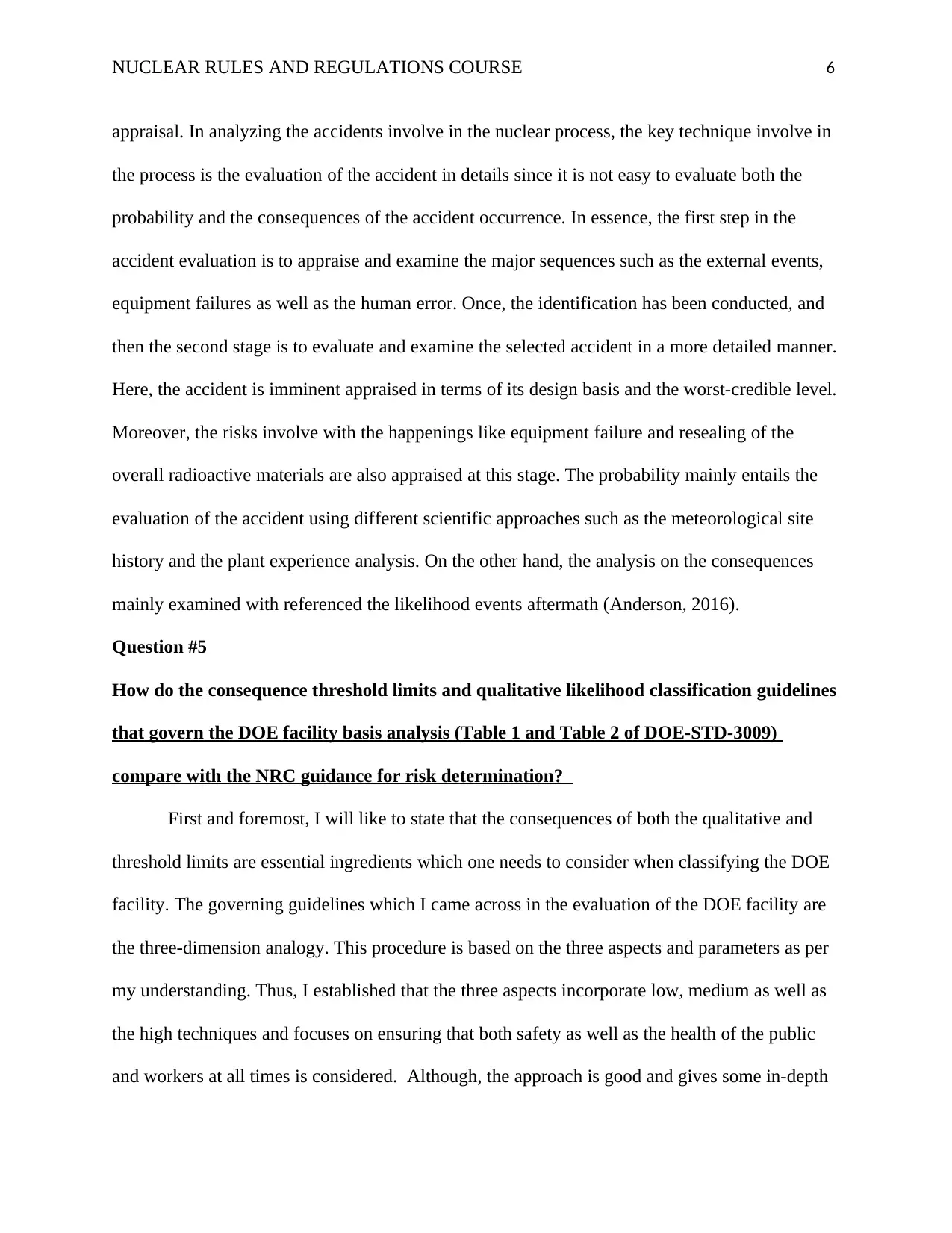
NUCLEAR RULES AND REGULATIONS COURSE 6
appraisal. In analyzing the accidents involve in the nuclear process, the key technique involve in
the process is the evaluation of the accident in details since it is not easy to evaluate both the
probability and the consequences of the accident occurrence. In essence, the first step in the
accident evaluation is to appraise and examine the major sequences such as the external events,
equipment failures as well as the human error. Once, the identification has been conducted, and
then the second stage is to evaluate and examine the selected accident in a more detailed manner.
Here, the accident is imminent appraised in terms of its design basis and the worst-credible level.
Moreover, the risks involve with the happenings like equipment failure and resealing of the
overall radioactive materials are also appraised at this stage. The probability mainly entails the
evaluation of the accident using different scientific approaches such as the meteorological site
history and the plant experience analysis. On the other hand, the analysis on the consequences
mainly examined with referenced the likelihood events aftermath (Anderson, 2016).
Question #5
How do the consequence threshold limits and qualitative likelihood classification guidelines
that govern the DOE facility basis analysis (Table 1 and Table 2 of DOE-STD-3009)
compare with the NRC guidance for risk determination?
First and foremost, I will like to state that the consequences of both the qualitative and
threshold limits are essential ingredients which one needs to consider when classifying the DOE
facility. The governing guidelines which I came across in the evaluation of the DOE facility are
the three-dimension analogy. This procedure is based on the three aspects and parameters as per
my understanding. Thus, I established that the three aspects incorporate low, medium as well as
the high techniques and focuses on ensuring that both safety as well as the health of the public
and workers at all times is considered. Although, the approach is good and gives some in-depth
appraisal. In analyzing the accidents involve in the nuclear process, the key technique involve in
the process is the evaluation of the accident in details since it is not easy to evaluate both the
probability and the consequences of the accident occurrence. In essence, the first step in the
accident evaluation is to appraise and examine the major sequences such as the external events,
equipment failures as well as the human error. Once, the identification has been conducted, and
then the second stage is to evaluate and examine the selected accident in a more detailed manner.
Here, the accident is imminent appraised in terms of its design basis and the worst-credible level.
Moreover, the risks involve with the happenings like equipment failure and resealing of the
overall radioactive materials are also appraised at this stage. The probability mainly entails the
evaluation of the accident using different scientific approaches such as the meteorological site
history and the plant experience analysis. On the other hand, the analysis on the consequences
mainly examined with referenced the likelihood events aftermath (Anderson, 2016).
Question #5
How do the consequence threshold limits and qualitative likelihood classification guidelines
that govern the DOE facility basis analysis (Table 1 and Table 2 of DOE-STD-3009)
compare with the NRC guidance for risk determination?
First and foremost, I will like to state that the consequences of both the qualitative and
threshold limits are essential ingredients which one needs to consider when classifying the DOE
facility. The governing guidelines which I came across in the evaluation of the DOE facility are
the three-dimension analogy. This procedure is based on the three aspects and parameters as per
my understanding. Thus, I established that the three aspects incorporate low, medium as well as
the high techniques and focuses on ensuring that both safety as well as the health of the public
and workers at all times is considered. Although, the approach is good and gives some in-depth
⊘ This is a preview!⊘
Do you want full access?
Subscribe today to unlock all pages.

Trusted by 1+ million students worldwide
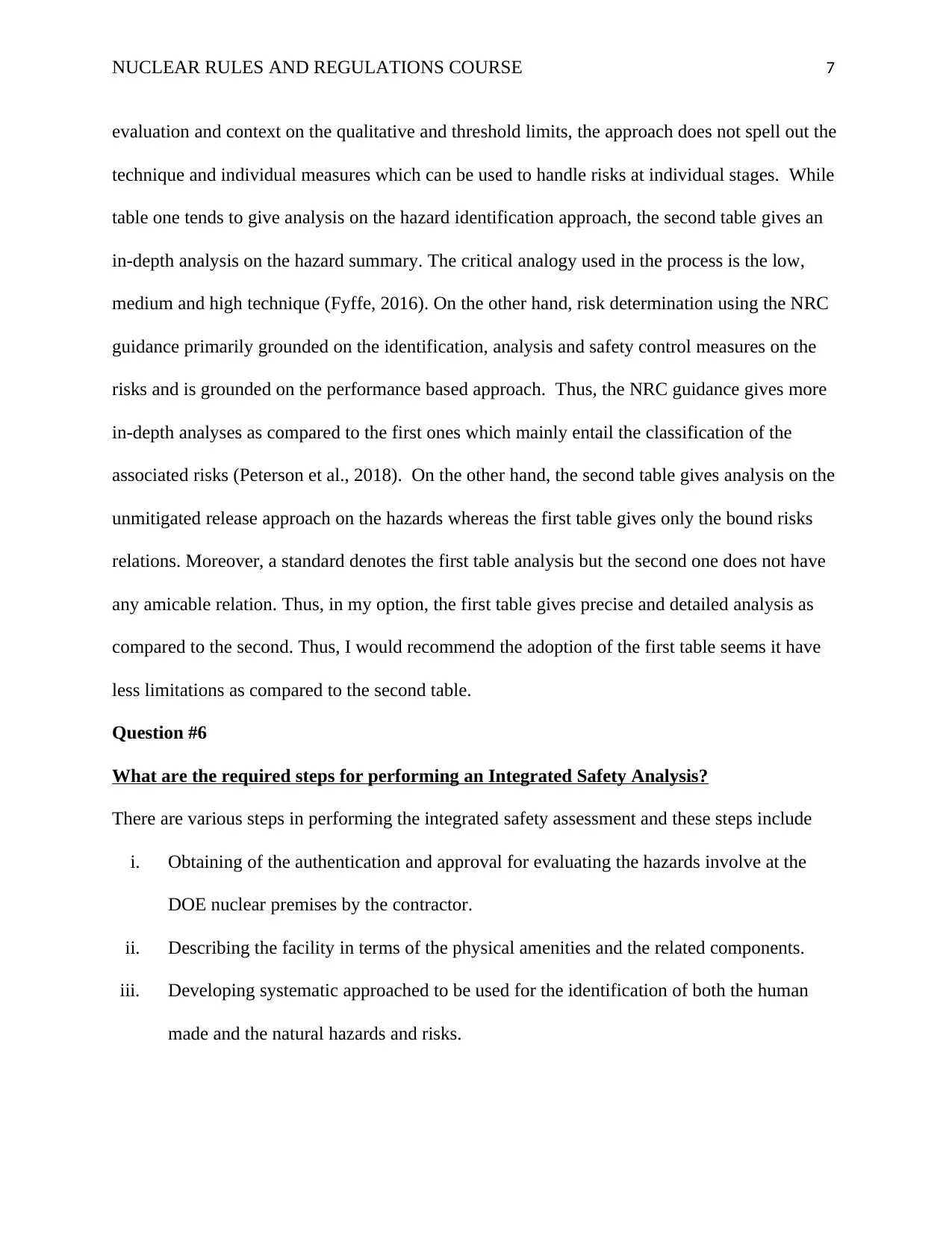
NUCLEAR RULES AND REGULATIONS COURSE 7
evaluation and context on the qualitative and threshold limits, the approach does not spell out the
technique and individual measures which can be used to handle risks at individual stages. While
table one tends to give analysis on the hazard identification approach, the second table gives an
in-depth analysis on the hazard summary. The critical analogy used in the process is the low,
medium and high technique (Fyffe, 2016). On the other hand, risk determination using the NRC
guidance primarily grounded on the identification, analysis and safety control measures on the
risks and is grounded on the performance based approach. Thus, the NRC guidance gives more
in-depth analyses as compared to the first ones which mainly entail the classification of the
associated risks (Peterson et al., 2018). On the other hand, the second table gives analysis on the
unmitigated release approach on the hazards whereas the first table gives only the bound risks
relations. Moreover, a standard denotes the first table analysis but the second one does not have
any amicable relation. Thus, in my option, the first table gives precise and detailed analysis as
compared to the second. Thus, I would recommend the adoption of the first table seems it have
less limitations as compared to the second table.
Question #6
What are the required steps for performing an Integrated Safety Analysis?
There are various steps in performing the integrated safety assessment and these steps include
i. Obtaining of the authentication and approval for evaluating the hazards involve at the
DOE nuclear premises by the contractor.
ii. Describing the facility in terms of the physical amenities and the related components.
iii. Developing systematic approached to be used for the identification of both the human
made and the natural hazards and risks.
evaluation and context on the qualitative and threshold limits, the approach does not spell out the
technique and individual measures which can be used to handle risks at individual stages. While
table one tends to give analysis on the hazard identification approach, the second table gives an
in-depth analysis on the hazard summary. The critical analogy used in the process is the low,
medium and high technique (Fyffe, 2016). On the other hand, risk determination using the NRC
guidance primarily grounded on the identification, analysis and safety control measures on the
risks and is grounded on the performance based approach. Thus, the NRC guidance gives more
in-depth analyses as compared to the first ones which mainly entail the classification of the
associated risks (Peterson et al., 2018). On the other hand, the second table gives analysis on the
unmitigated release approach on the hazards whereas the first table gives only the bound risks
relations. Moreover, a standard denotes the first table analysis but the second one does not have
any amicable relation. Thus, in my option, the first table gives precise and detailed analysis as
compared to the second. Thus, I would recommend the adoption of the first table seems it have
less limitations as compared to the second table.
Question #6
What are the required steps for performing an Integrated Safety Analysis?
There are various steps in performing the integrated safety assessment and these steps include
i. Obtaining of the authentication and approval for evaluating the hazards involve at the
DOE nuclear premises by the contractor.
ii. Describing the facility in terms of the physical amenities and the related components.
iii. Developing systematic approached to be used for the identification of both the human
made and the natural hazards and risks.
Paraphrase This Document
Need a fresh take? Get an instant paraphrase of this document with our AI Paraphraser
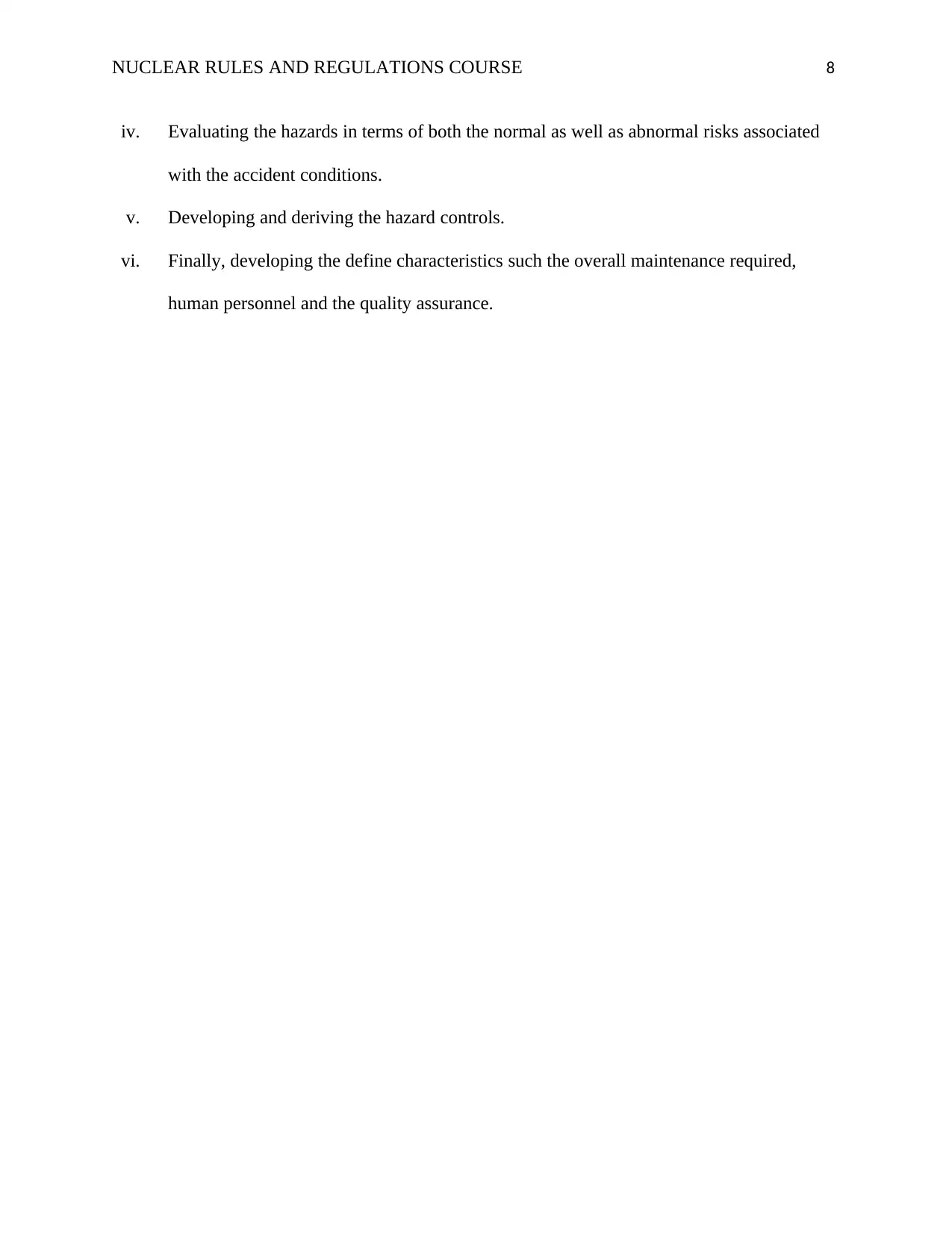
NUCLEAR RULES AND REGULATIONS COURSE 8
iv. Evaluating the hazards in terms of both the normal as well as abnormal risks associated
with the accident conditions.
v. Developing and deriving the hazard controls.
vi. Finally, developing the define characteristics such the overall maintenance required,
human personnel and the quality assurance.
iv. Evaluating the hazards in terms of both the normal as well as abnormal risks associated
with the accident conditions.
v. Developing and deriving the hazard controls.
vi. Finally, developing the define characteristics such the overall maintenance required,
human personnel and the quality assurance.
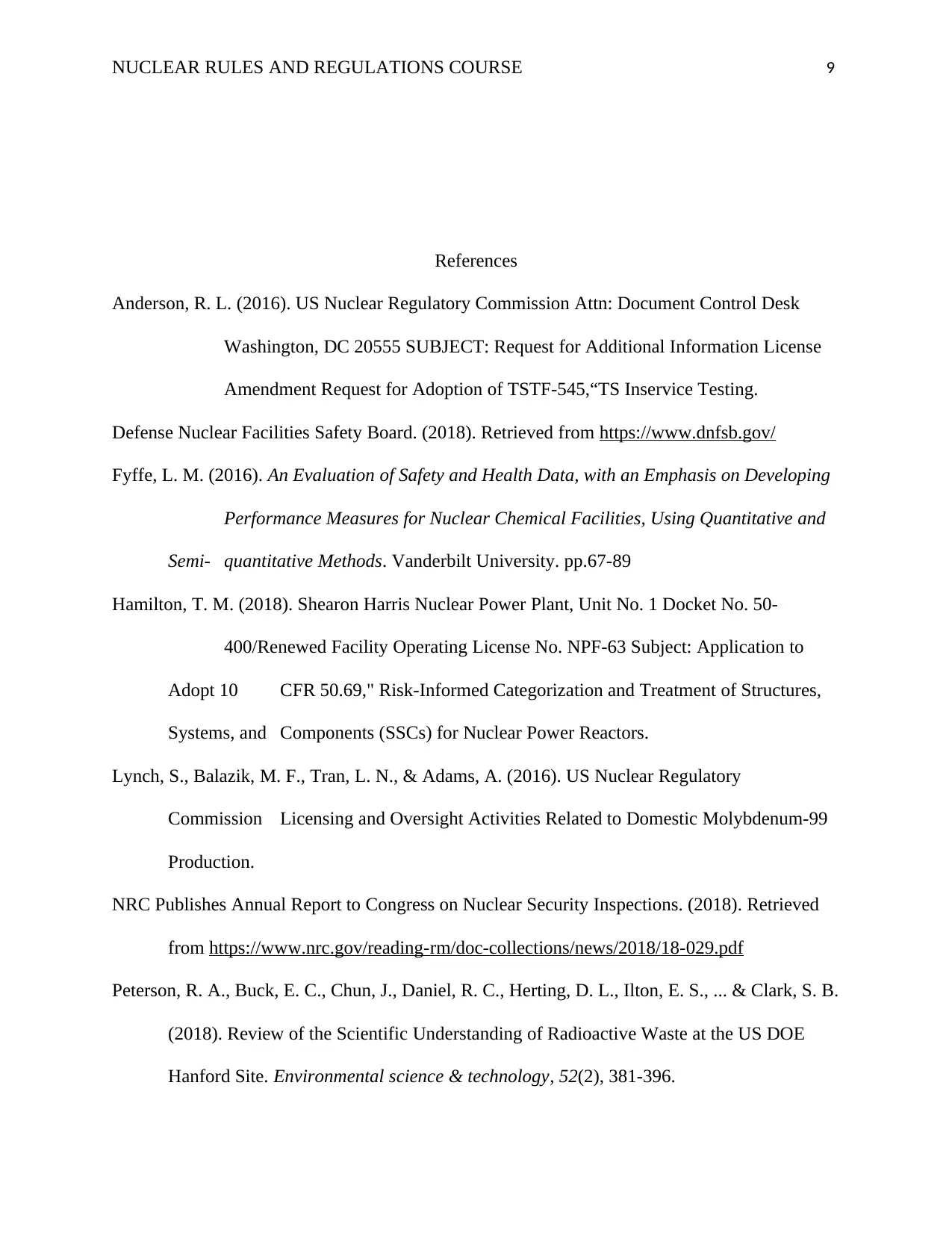
NUCLEAR RULES AND REGULATIONS COURSE 9
References
Anderson, R. L. (2016). US Nuclear Regulatory Commission Attn: Document Control Desk
Washington, DC 20555 SUBJECT: Request for Additional Information License
Amendment Request for Adoption of TSTF-545,“TS Inservice Testing.
Defense Nuclear Facilities Safety Board. (2018). Retrieved from https://www.dnfsb.gov/
Fyffe, L. M. (2016). An Evaluation of Safety and Health Data, with an Emphasis on Developing
Performance Measures for Nuclear Chemical Facilities, Using Quantitative and
Semi- quantitative Methods. Vanderbilt University. pp.67-89
Hamilton, T. M. (2018). Shearon Harris Nuclear Power Plant, Unit No. 1 Docket No. 50-
400/Renewed Facility Operating License No. NPF-63 Subject: Application to
Adopt 10 CFR 50.69," Risk-Informed Categorization and Treatment of Structures,
Systems, and Components (SSCs) for Nuclear Power Reactors.
Lynch, S., Balazik, M. F., Tran, L. N., & Adams, A. (2016). US Nuclear Regulatory
Commission Licensing and Oversight Activities Related to Domestic Molybdenum-99
Production.
NRC Publishes Annual Report to Congress on Nuclear Security Inspections. (2018). Retrieved
from https://www.nrc.gov/reading-rm/doc-collections/news/2018/18-029.pdf
Peterson, R. A., Buck, E. C., Chun, J., Daniel, R. C., Herting, D. L., Ilton, E. S., ... & Clark, S. B.
(2018). Review of the Scientific Understanding of Radioactive Waste at the US DOE
Hanford Site. Environmental science & technology, 52(2), 381-396.
References
Anderson, R. L. (2016). US Nuclear Regulatory Commission Attn: Document Control Desk
Washington, DC 20555 SUBJECT: Request for Additional Information License
Amendment Request for Adoption of TSTF-545,“TS Inservice Testing.
Defense Nuclear Facilities Safety Board. (2018). Retrieved from https://www.dnfsb.gov/
Fyffe, L. M. (2016). An Evaluation of Safety and Health Data, with an Emphasis on Developing
Performance Measures for Nuclear Chemical Facilities, Using Quantitative and
Semi- quantitative Methods. Vanderbilt University. pp.67-89
Hamilton, T. M. (2018). Shearon Harris Nuclear Power Plant, Unit No. 1 Docket No. 50-
400/Renewed Facility Operating License No. NPF-63 Subject: Application to
Adopt 10 CFR 50.69," Risk-Informed Categorization and Treatment of Structures,
Systems, and Components (SSCs) for Nuclear Power Reactors.
Lynch, S., Balazik, M. F., Tran, L. N., & Adams, A. (2016). US Nuclear Regulatory
Commission Licensing and Oversight Activities Related to Domestic Molybdenum-99
Production.
NRC Publishes Annual Report to Congress on Nuclear Security Inspections. (2018). Retrieved
from https://www.nrc.gov/reading-rm/doc-collections/news/2018/18-029.pdf
Peterson, R. A., Buck, E. C., Chun, J., Daniel, R. C., Herting, D. L., Ilton, E. S., ... & Clark, S. B.
(2018). Review of the Scientific Understanding of Radioactive Waste at the US DOE
Hanford Site. Environmental science & technology, 52(2), 381-396.
⊘ This is a preview!⊘
Do you want full access?
Subscribe today to unlock all pages.

Trusted by 1+ million students worldwide
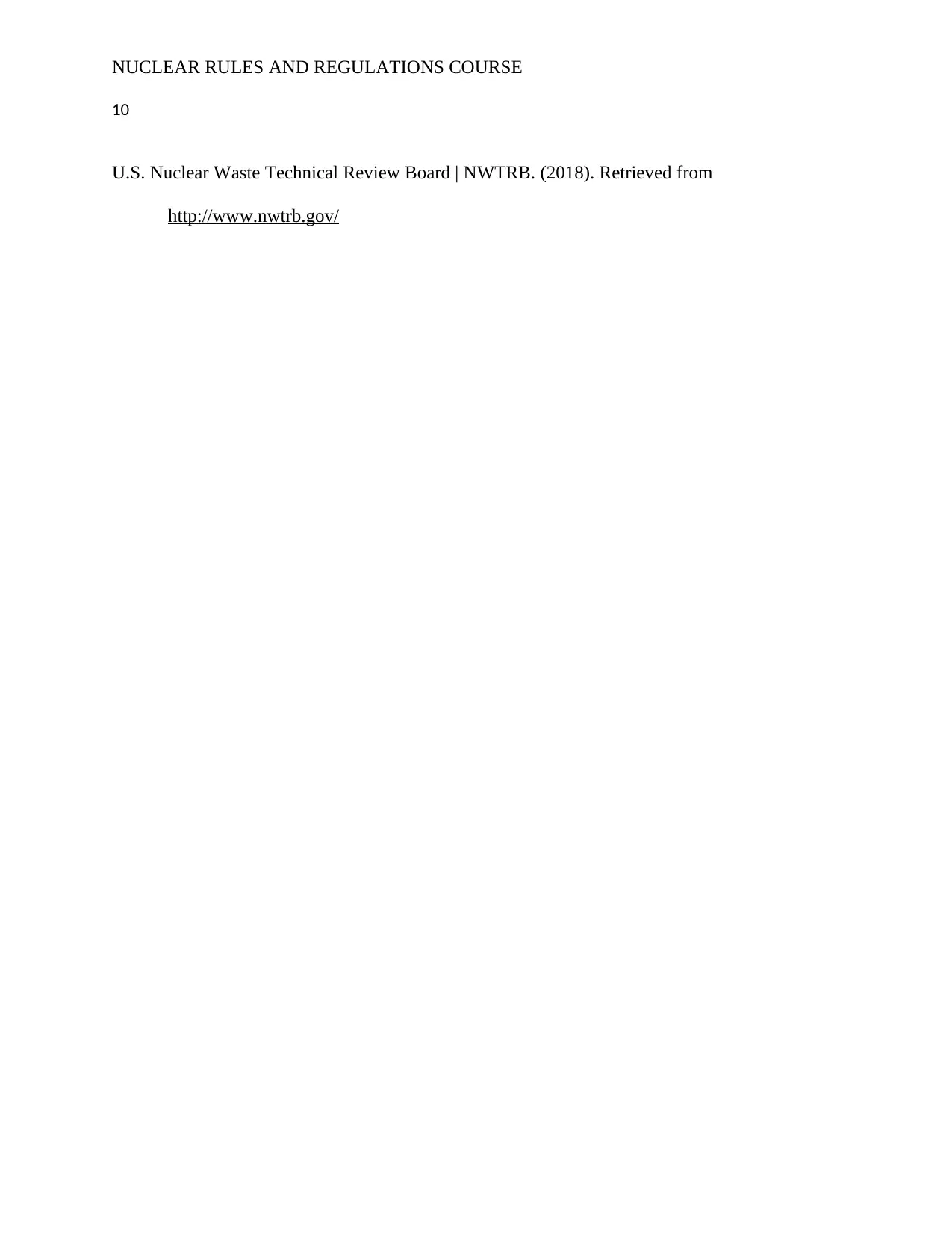
NUCLEAR RULES AND REGULATIONS COURSE
10
U.S. Nuclear Waste Technical Review Board | NWTRB. (2018). Retrieved from
http://www.nwtrb.gov/
10
U.S. Nuclear Waste Technical Review Board | NWTRB. (2018). Retrieved from
http://www.nwtrb.gov/
1 out of 10
Your All-in-One AI-Powered Toolkit for Academic Success.
+13062052269
info@desklib.com
Available 24*7 on WhatsApp / Email
![[object Object]](/_next/static/media/star-bottom.7253800d.svg)
Unlock your academic potential
Copyright © 2020–2025 A2Z Services. All Rights Reserved. Developed and managed by ZUCOL.

